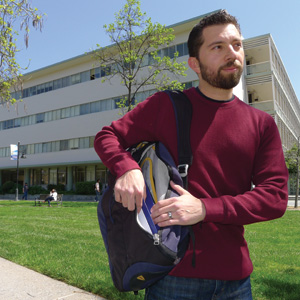Nelson Hunter knows what it’s like for a kid to do more with less. Growing up in San Jose, he remembers going to a book drive as a third grader to pick up a school’s unwanted textbooks. Hunter returned home and went about pretending to be teacher. It wasn’t much to work with, but he made do with the musty old books and daydreamed about a career in the classroom.
Now, Hunter is taking more than a full load at San Jose State University to complete his teaching credential. A teaching assistant for 11 years—who also worked as a bartender and snowboard instructor—Hunter has a unique perspective. He has witnessed budget cuts to education at every level, from kindergarten through college, and seen how students and teachers are jostling to stay afloat with each subsequent school year.
“When I worked in elementary schools at a 1-to-20 [teacher-to-student] ratio, it was such a luxury,” Hunter says. “You had so much time to engage these students and give them an enriching, awesome education. Now you’ve got third- and fourth-grade classrooms with 35 students. It’s hard for a teacher to reach so many students at that level.”
The strain is also being felt in Hunter’s own courses at SJSU, which have ballooned from 22 graduate students to 30 or more. Classroom counts, already highacross the board, are about to becoming bigger.
When Gov. Jerry Brown called off budget negotiations last week with Republican lawmakers, who have steadfastly refused to allow a special election in June to extend several taxes for five years, the outlook for education became even bleaker.
California’s nonpartisan legislative analyst’s office has said the consequences of not covering a little more than half of the state’s $26 billion deficit through tax extensions would result in $5 billion being cut from K-12 education, $585 million from community colleges and $1.1 billion from universities.
Pink slips were sent out to school districts across the state in March, and updated projections will be going out next month. Effects on Silicon Valley will be mixed. While most districts in San Jose will be able to weather the storm effectively for the 2011-12 school year, it’s the coming years that will feature the fiercest cuts if the tax extensions aren’t approved.
Dan Moser, superintendent for East Side Union High School District, said his district is bracing to cut 22 teaching and administrative positions this coming year, and an additional 42 full-time employees (clerical, custodians, campus monitors, etc.) will lose their jobs if the tax extensions are not approved. The worst, however, would come over the next two years.
“We’re projecting being $13 million short for the school year in ‘12-13, and it could be as high as $20 million for ‘13-14,” Moser says. “If you don’t make the cuts this year, you have to make it up the following year.”
Having hundreds of dollars less per student, if not more than a thousand, East Side Union—one of the more impoverished districts in Northern California—would also be forced to
{pagebreak}
cut back to one school counselor per 1,000 students. The positions are seen as imperative in helping many disadvantaged children pursue college.
“We’ll take every resource we can to get through next year, and then we’ll have significant problems,” Moser says. “The issue is, at least for us, this is the third year in a row with layoffs, and we have basically come to the end, where you can’t solve that problem except for layoffs.”
Then there is the real possibility for many districts in California of having to trim the school calendar by a month—down from eight to seven—continuing to stuff more kids into classrooms and eliminating external support programs like health and pre-college counseling.
“As you drive by a school every day, you don’t see the differences from the street,” Moser says. “It’s only once you get inside or have a child that you see what’s missing.”
Hidden Costs
According to the 2011 State of Education report given by Santa Clara County Superintendent of Schools Charles Weis, 40 percent of all county public high school students are not proficient in their grade-level skills, and about 2,300 middle and high school students drop out each year. Those numbers would almost certainly increase if education funding is cut.
“The youngsters need that one-on-one time,” Moser says.
The same could be said about many young, innovative and energetic teachers, who, due to public school collective bargaining agreements with teacher unions, would be the first to be laid off because they lack seniority.
Local charter schools, which number 36 in Santa Clara County and had more than 17,000 students in the fall, also receive public funding but are not always beholden to the same restrictions on judging teachers.
“It’s one of the things that allows charter schools to be successful in general and weather this crisis more effectively than traditional schools can,” says Jed Wallace, president of the California Charter Schools Association.
But Wallace notes that a wave of charters could also be forced to confront dire consequences due to budget cutbacks. While public schools can continue operating with the aid of low-interest tax-revenue-anticipation notes when the state defers payments, regulations regarding charter schools force them to resort to taking traditional bank loans that can escalate in the long run.
Tricia Johnson, 36, who is in the same SJSU teaching credential program as Hunter and will also be graduating in December, says she remains optimistic about her future career, but knows there will be innumerable obstacles to overcome for teachers and students if education continues to get short shrift from legislators.
“Honestly, coming out of school and trying to find a job in this market, I feel like my hands are tied,” Johnson says. “I don’t feel like there’s even much to do at a grass-roots level.”

 The Sharks’ Time Has Come
The Sharks’ Time Has Come  The Green at Avalon Nightclub
The Green at Avalon Nightclub 









